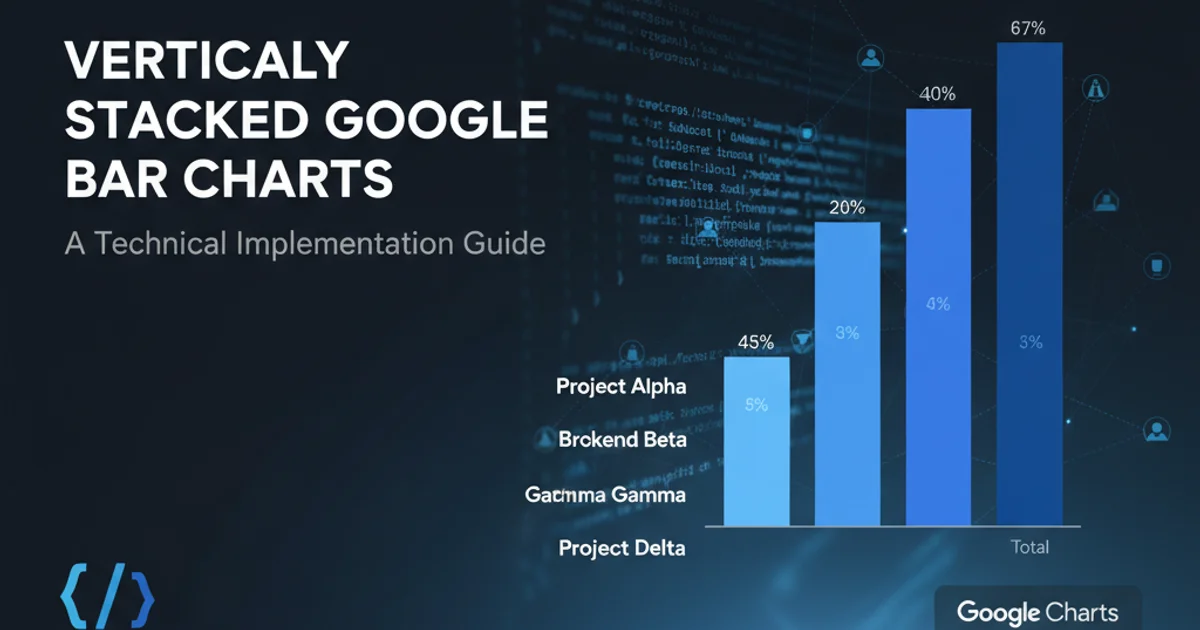Vertically stacked Google Bar Charts
Categories:
Creating Vertically Stacked Google Bar Charts

Learn how to implement vertically stacked bar charts using Google Charts, focusing on data preparation and configuration for effective visualization.
Google Charts provides a powerful and flexible way to visualize data on your web pages. While horizontal stacked bar charts are common, sometimes a vertical orientation is preferred for better readability or to fit specific design requirements. This article will guide you through the process of creating vertically stacked bar charts using the Google Visualization API, covering data structuring, chart options, and practical implementation.
Understanding Stacked Bar Charts in Google Charts
Google Charts' Bar Chart (which is essentially a horizontal bar chart) and Column Chart (a vertical bar chart) can both be configured to display stacked data. The key to achieving a stacked effect is the isStacked: true option. For a vertically stacked bar chart, you'll typically use the ColumnChart type. The challenge often lies in correctly structuring your data table to represent the stacked segments for each category.
flowchart TD
A[Start: Define Data Requirements] --> B{Choose Chart Type: ColumnChart}
B --> C[Prepare Data Table: Columns for Categories & Stacked Series]
C --> D[Configure Chart Options: isStacked: true]
D --> E[Draw Chart: Attach to HTML Element]
E --> F[End: Display Vertically Stacked Bar Chart]Workflow for creating a vertically stacked Google Column Chart.
Data Preparation for Vertical Stacking
The structure of your DataTable is crucial. For a vertically stacked column chart, your first column should represent the categories (e.g., 'Quarter', 'Month', 'Product'), and subsequent columns should represent the individual series that will stack on top of each other for each category. Each row will then correspond to a single category, with values for each stacked segment.
google.charts.load('current', {'packages':['corechart']});
google.charts.setOnLoadCallback(drawChart);
function drawChart() {
var data = google.visualization.arrayToDataTable([
['Quarter', 'Sales A', 'Sales B', 'Sales C'],
['Q1', 100, 20, 30],
['Q2', 110, 25, 35],
['Q3', 90, 15, 25],
['Q4', 120, 30, 40]
]);
var options = {
title: 'Company Sales by Quarter (Stacked)',
isStacked: true,
height: 400,
legend: { position: 'top', maxLines: 3 },
vAxis: {
title: 'Total Sales'
},
hAxis: {
title: 'Quarter'
}
};
var chart = new google.visualization.ColumnChart(document.getElementById('chart_div'));
chart.draw(data, options);
}
Example JavaScript code for a vertically stacked Google Column Chart.
isStacked: true option applies to both BarChart (horizontal) and ColumnChart (vertical). The choice between them depends on your desired orientation.Customizing Your Vertically Stacked Chart
Google Charts offers extensive customization options. Beyond isStacked, you can control colors, legends, axes titles, tooltips, and more. For stacked charts, pay attention to the legend position to ensure clarity, especially when you have many series. You can also use series options to customize individual stacks, such as assigning specific colors or roles.
var options = {
title: 'Project Progress by Phase',
isStacked: true,
height: 500,
legend: { position: 'right' },
colors: ['#4CAF50', '#FFC107', '#F44336'], // Custom colors for series
vAxis: {
title: 'Percentage Complete',
minValue: 0,
maxValue: 100
},
hAxis: {
title: 'Project Phase'
},
tooltip: { isHtml: true } // Enable HTML tooltips for richer info
};
Advanced options for a vertically stacked Google Column Chart.
1. Load Google Charts Library
Include the Google Charts loader script in your HTML file and specify the 'corechart' package. This ensures all necessary components are available.
2. Prepare Your Data
Create a google.visualization.DataTable or use arrayToDataTable with your data. The first column should be your categories, and subsequent columns should be the series that will stack.
3. Define Chart Options
Set up your chart options object. Crucially, set isStacked: true. Customize titles, axis labels, colors, and legend as needed for your visualization.
4. Instantiate and Draw the Chart
Create a new google.visualization.ColumnChart instance, passing the ID of the HTML element where the chart will be rendered. Then, call the draw() method with your data and options.